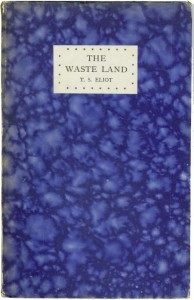 After James Joyce and George Orwell, we now have another 20th-century classic in the public domain exhibiting added value in its print legacy. A rare UK first edition copy of “The Waste Land” by T. S. Eliot, donated to Oxfam, is to be auctioned at Bonhams in London on June 25, where it is estimated to fetch £2,000-3,000 ($3,100-4,700).
After James Joyce and George Orwell, we now have another 20th-century classic in the public domain exhibiting added value in its print legacy. A rare UK first edition copy of “The Waste Land” by T. S. Eliot, donated to Oxfam, is to be auctioned at Bonhams in London on June 25, where it is estimated to fetch £2,000-3,000 ($3,100-4,700).
This first edition is one of only 460 copies hand-printed by Leonard Woolf and Virginia Woolf at the Hogarth Press in September 1923.

Fortunately for modern readers, The Waste Land has been a public domain work in the United States since 1998. According to Rickard A. Parker, the poem was registered for U.S. copyright in 1922, with a protection period at the time of 28 years, subsequently extended until 1998. Had it been registered one year later, in 1923, it would still be under copyright until 2019.
Project Gutenberg produced its digital edition of “The Waste Land” in May 1998 (ebook no. 1321), followed by an audio edition in May 2007 (ebook no. 21602). In the United Kingdom, where the poem was begun, “The Waste Land” is still under copyright until 2035—70 years after Eliot’s death.
There are many other online and digital versions of the work available—which alas, is just as well. The Gutenberg edition is very imperfect, even in its basic HTML rendition, with incorrect breaks between stanzas and footnotes interpolated into the text where they break up the flow. (This is not just a matter of verse formatting, by the way: Any prose work on Gutenberg that had its text broken up by random footnotes would look almost as poorly digitized.)
In Gutenberg’s Kindle version of the poem, critical italics that crop up time and again throughout the poem’s text just do not appear at all. Project Gutenberg has a fairly poor record in retrospective quality control, especially for some of its earlier editions, and “The Waste Land” is one that cries out for a revision. The 2011 Bartleby edition at least has no such problems.
I’m not writing this as a roundabout apology for publishers who charge for public-domain works, but it strikes me that any house that produced a properly redacted and formatted e-book edition of “The Waste Land,” so long as it doesn’t overcharge too invidiously, would be doing readers a favor. Faber and Faber’s 2010 edition of “The Waste Land and Other Poems” retails on the Amazon Kindle Store for $5.25.
The Bonhams auction shows how much readers still value this work. If Gutenberg wants to live up to its reputation, and produce an edition worthy of respect, it ought to take another look at “The Waste Land.” Otherwise, the world’s number one source of public-domain literature is blocking the market with a sub-standard item that does the cause of copyright-free work, and e-book poetry, no good at all.
































The auction sale price is because of the rarity of a THING, not about the quality of the work printed in this thing, whether it is or isn’t in public domain, or is or isn’t in digital form in whatever quality.
Talk about reaching for a topic.
Marilynn, I’m happy to use whatever topic comes along that demonstrates that: 1) poetry ebook formatting needs to be done more carefully and consistently; 2) Project Gutenberg needs to redo some of its earlier digitizations with the respect they deserve; and 3) the current global copyright regime for dead authors’ works is a farce. Whaddaya know, this topic touched on all three at once. Didn’t have to reach very far.
A lot of the early texts at PG were text files only or what they used to call plain vanilla. This means that textual nuance like italics were ignored. This, in my mind, can be just as wrong as skipping or exchanging words. PG does need to redo these books especially for cannon authors like Henry James.
Perhaps you should check your facts before dissing on PG.Their version was updated in April and the HTML looks great!
I agree that the print copy is a thing or artifact, but so is an Apple I device that would bring a lot more. The sidebar story is transmission of conceptual works in physical things; a bit of paradox, but well related to human evolution.
just i, I did check. When I wrote the article, the HTML still had precisely the issues I mentioned. Checking just now, in Chrome and Firefox, the HTML for the entire poem is coming up all italic, so I’m not sure what’s going on with the rendering. Part III of the poem, The Fire Sermon, still has missing breaks between sections. There and elsewhere there are also editorial footnotes appearing within the main text.